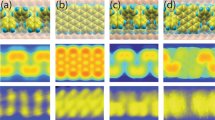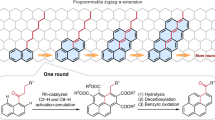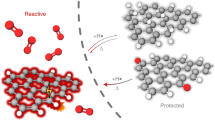Abstract
The properties of graphene nanoribbons (GNRs)1,2,3,4,5—such as conductivity or semiconductivity, charge mobility and on/off ratio—depend greatly on their width, length and edge structure. Existing bottom–up methods used to synthesize GNRs cannot achieve control over all three of these parameters simultaneously, and length control is particularly challenging because of the nature of step-growth polymerization6,7,8,9,10,11,12,13,14,15,16,17,18. Here we describe a living annulative π-extension (APEX)19 polymerization technique that enables rapid and modular synthesis of GNRs, as well as control over their width, edge structure and length. In the presence of palladium/silver salts, o-chloranil and an initiator (phenanthrene or diphenylacetylene), the benzonaphthosilole monomer polymerizes in an annulative manner to furnish fjord-type GNRs. The length of these GNRs can be controlled by simply changing the initiator-to-monomer ratio, achieving the synthesis of GNR block copolymers. This method represents a type of direct C–H arylation polymerization20 and ladder polymerization21, activating two C–H bonds of polycyclic aromatic hydrocarbons and constructing one fused aromatic ring per chain propagation step.
This is a preview of subscription content, access via your institution
Access options
Access Nature and 54 other Nature Portfolio journals
Get Nature+, our best-value online-access subscription
$29.99 / 30 days
cancel any time
Subscribe to this journal
Receive 51 print issues and online access
$199.00 per year
only $3.90 per issue
Buy this article
- Purchase on Springer Link
- Instant access to full article PDF
Prices may be subject to local taxes which are calculated during checkout




Similar content being viewed by others
Data availability
The datasets generated and/or analysed during the current study are available from the corresponding authors on reasonable request.
Change history
25 November 2020
This article has been retracted. Please see the Retraction Notice for more detail: https://doi.org/10.1038/s41586-020-2950-0.
References
Dutta, S. & Pati, S. K. Novel properties of graphene nanoribbons: a review. J. Mater. Chem. 20, 8207–8223 (2010).
Li, X., Wang, X., Zhang, L., Lee, S. & Dai, H. Chemically derived, ultrasmooth graphene nanoribbon semiconductors. Science 319, 1229–1232 (2008).
Son, Y. W., Cohen, M. L. & Louie, S. G. Half-metallic graphene nanoribbons. Nature 444, 347–349 (2006); corrigendum 446, 342 (2007).
Yang, L., Park, C. H., Son, Y. W., Cohen, M. L. & Louie, S. G. Quasiparticle energies and band gaps in graphene nanoribbons. Phys. Rev. Lett. 99, 186801 (2007).
Ritter, K. A. & Lyding, J. W. The influence of edge structure on the electronic properties of graphene quantum dots and nanoribbons. Nat. Mater. 8, 235–242 (2009).
Ma, L., Wang, J. & Ding, F. Recent progress and challenges in graphene nanoribbon synthesis. ChemPhysChem 14, 47–54 (2013).
Segawa, Y., Ito, H. & Itami, K. Structurally uniform and atomically precise carbon nanostructures. Nat. Rev. Mater. 1, 15002 (2016).
Chen, L., Hernandez, Y., Feng, X. & Müllen, K. From nanographene and graphene nanoribbons to graphene sheets: chemical synthesis. Angew. Chem. Int. Ed. 51, 7640–7654 (2012).
Narita, A., Feng, X. & Müllen, K. Bottom-up synthesis of chemically precise graphene nanoribbons. Chem. Rec. 15, 295–309 (2015).
Yang, X. et al. Two-dimensional graphene nanoribbons. J. Am. Chem. Soc. 130, 4216–4217 (2008).
Cai, J. et al. Atomically precise bottom-up fabrication of graphene nanoribbons. Nature 466, 470–473 (2010).
Narita, A. et al. Synthesis of structurally well-defined and liquid-phase-processable graphene nanoribbons. Nat. Chem. 6, 126–132 (2014).
Ruffieux, P. et al. On-surface synthesis of graphene nanoribbons with zigzag edge topology. Nature 531, 489–492 (2016).
Talirz, L. et al. On-surface synthesis and characterization of 9-atom wide armchair graphene nanoribbons. ACS Nano 11, 1380–1388 (2017).
Sakaguchi, H., Song, S., Kojima, T. & Nakae, T. Homochiral polymerization-driven selective growth of graphene nanoribbons. Nat. Chem. 9, 57–63 (2017).
Jordan, R. S. et al. Synthesis of graphene nanoribbons via the topochemical polymerization and subsequent aromatization of a diacetylene precursor. Chem 1, 78–90 (2016).
Jordan, R. S. et al. Synthesis of N = 8 armchair graphene nanoribbons from four distinct polydiacetylenes. J. Am. Chem. Soc. 139, 15878–15890 (2017).
Yang, W., Lucotti, A., Tommasini, M. & Chalifoux, W. A. Bottom-up synthesis of soluble and narrow graphene nanoribbons using alkyne benzannulations. J. Am. Chem. Soc. 138, 9137–9144 (2016).
Ito, H., Ozaki, K. & Itami, K. Annulative π-extension (APEX): an enabling reaction for rapid access to fused aromatics, heteroaromatics, and nanographenes. Angew. Chem. Int. Ed. 56, 11144–11164 (2017).
Pouliot, J.-R., Grenier, F., Blaskovits, J. T., Beaupré, S. & Leclerc, M. Direct (hetero)arylation polymerization: simplicity for conjugated polymer synthesis. Chem. Rev. 116, 14225–14274 (2016).
Teo, Y. C., Lai, H. W. H. & Xia, Y. Synthesis of ladder polymers: developments, challenges, and opportunities. Chemistry 23, 14101–14112 (2017).
Ozaki, K., Kawasumi, K., Shibata, M., Ito, H. & Itami, K. One-shot K-region-selective annulative π-extension for nanographene synthesis and functionalization. Nat. Commun. 6, 6251 (2015).
Yano, Y., Ito, H., Segawa, Y. & Itami, K. Helically twisted tetracene: synthesis, crystal structure, and photophysical properties of hexabenzo[a,c,fg,j,l,op]tetracene. Synlett 27, 2081–2084 (2016).
Yokozawa, T. & Ohta, Y. Transformation of step-growth polymerization into living chain-growth polymerization. Chem. Rev. 116, 1950–1968 (2016).
Huang, Y. et al. Poly(ethylene oxide) functionalized graphene nanoribbons with excellent solution processability. J. Am. Chem. Soc. 138, 10136–10139 (2016).
Webster, O. W. Living polymerization methods. Science 251, 887–893 (1991).
Ozaki, K. et al. One-step annulative π-extension of alkynes with dibenzosiloles or dibenzogermoles by palladium/o-chloranil catalysis. Angew. Chem. Int. Ed. 56, 1361–1364 (2017).
Prezzi, D., Varsano, D., Ruini, A., Marini, A. & Molinari, E. Optical properties of graphene nanoribbons: the role of many-body effects. Phys. Rev. B 77, 041404 (2008).
Vandescuren, M., Hermet, P., Meunier, V., Henrard, L. & Lambin, P. Theoretical study of the vibrational edge modes in graphene nanoribbons. Phys. Rev. B 78, 195401 (2008).
Gillen, R., Mohr, M. & Maultzschm, J. Symmetry properties of vibrational modes in graphene nanoribbons. Phys. Rev. B 81, 205426 (2010).
Acknowledgements
This work was supported by the ERATO programme from JST (JPMJER1302 to K.I.), the JSPS KAKENHI (grants JP26810057, JP16H00907, JP17K1955 and JP18H02019 to H.I.), the SUMITOMO Foundation (141495 to H.I.) and the DAIKO Foundation (H.I.). We acknowledge Taoka Chemical Co., Ltd for providing samples. We thank K. Kuwata (Nagoya University) for MALDI–TOF mass measurements; M. Kamigaito and M. Uchiyama (Nagoya University) for measurements of molecular weight by size-exclusion chromatography multi-angle light scattering (SEC-MALS); T. Hashizume (Hitachi Ltd and Tokyo Institute of Technology) for advice on the STM and AFM measurements; C. M. Crudden (Queen’s University and Nagoya University), G. J. P. Perry (Nagoya University) and A. Miyazaki (Nagoya University) for comments and proofreading. Computations were performed at the Research Center for Computational Science, Okazaki, Japan. ITbM is supported by the World Premier International Research Center (WPI) Initiative, Japan.
Reviewer information
Nature thanks Lawrence T. Scott and the other anonymous reviewer(s) for their contribution to the peer review of this work.
Author information
Authors and Affiliations
Contributions
K.I. and H.I. conceived the idea and directed the project. Y.Y., K. Matsushima and H.I. conducted the experiments and theoretical calculations. K. Matsui, A.T. and N.M. conducted the STM experiments. F.W. conducted the AFM experiments. Y.M. supervised the scanning probe microscopy experiments and provided advice on spectroscopic analysis. H.I. and K.I. prepared the manuscript with feedback from the other authors.
Corresponding authors
Ethics declarations
Competing interests
The authors declare no competing interests.
Additional information
Publisher’s note: Springer Nature remains neutral with regard to jurisdictional claims in published maps and institutional affiliations.
Extended data figures and tables
Extended Data Fig. 1 Mass spectroscopy analysis and confirmation of livingness of APEX polymerization.
a, MALDI–TOF mass spectrum (reflection mode) of fjord-type GNR 2 (M n = 1.3 × 104, Đ = 1.23) with trans-2-[3-(4-tert-butylphenyl)-2-methyl-2-propenylidene]malononitrile (DCTB) as the matrix. b, Summary of observed and calculated molecular ion peaks. c, Confirmation of livingness of APEX polymerization by one-pot SEC analyses. d, SEC charts of the reaction progress after 1 h, 3 h and 12 h.
Extended Data Fig. 2 Raman spectroscopy analyses of fjord-type GNR 2 and synthesis of model dimer.
a, Raman spectra of fjord-type GNR 2, obtained with a 532-nm excitation laser. b, Synthesis of model dimer 3b by step-by-step APEX reaction of phenanthrene. c, Synthesis of model dimer 3a by APEX reaction.
Extended Data Fig. 3 1H NMR spectroscopy analysis of fjord-type GNR 2.
Observed 1H NMR spectra of GNR 2 (in Cl2CDCDCl2 at 120 °C) and dimer 3a (in CD2Cl2 at 22 °C). All of the peaks of 3a range from 7.2 to 7.9 p.p.m. Two doublet-of-doublet peaks appear at a higher magnetic field (chemical shift δ = 7.2–7.3 p.p.m.), which are attributed to the most shielded aromatic hydrogen atoms, in the orange-coloured fjord regions. Other aromatic hydrogen atoms in the fjord regions next to the alkyl substituents (red circle) are found as a singlet peak at 7.32 p.p.m. On the other hand, the most deshielded aromatic hydrogen atoms in the bay and cove regions appear at 7.8–7.9 p.p.m. The 1H NMR spectrum of fjord-type GNR 2 shows broadened peaks at 7.0–8.3 p.p.m., which is expected to reflect the repeating [5]helicene structure.
Extended Data Fig. 4 Comparison of IR, absorption, emission and Raman spectroscopy of 2 and 5.
a, Observed IR spectra of GNRs 2 and 5 (blue and red lines) and IR spectrum of tetramer 10 (black line) predicted by DFT calculations at the B3LYP/6-31G(d) level of theory. b, UV-vis absorption spectra of GNRs 2 and 5 (blue and red lines). c, Emission spectra of GNRs 2 and 5 (blue and red lines) excited at 320 nm. d, Raman spectra of GNR 5, obtained by excitation by a 532-nm laser.
Extended Data Fig. 5 Analytical SEC, IR and Raman spectroscopy data for fjord-type GNR 7.
a, SEC charts of the crude product of reactions with various I′/M ratios. b, c, M n and M w profiles versus M/I′ and conversion of the monomer in the living APEX polymerization. d, Observed IR spectra of GNR 7 with different polymer lengths (blue, green, yellow and red lines) and IR spectrum of dimer 11 (black line) predicted by DFT calculations at the B3LYP/6-31G(d) level of theory. e, Raman spectra of GNR 7 with different polymer lengths (blue, green, yellow and red lines), obtained with excitation by a 532 nm laser.
Extended Data Fig. 6 Analytical MALDI–TOF data for fjord-type GNR 7.
a, MALDI–TOF mass spectrum (reflection mode) of fjord-type GNR 7 (M n = 1.2 × 104 Da, Đ = 1.04) with DCTB as the matrix. b, Summary of observed and calculated molecular ion peaks.
Extended Data Fig. 7 Formation of armchair-type GNR 8.
a–d, MALDI–TOF mass spectra (reflection mode) of armchair-type GNR 8 (M n = 8.3 × 103 Da, Đ = 1.31) with 7,7,8,8-tetracyanoquinodimethane as the matrix and AgOCOCF3 as an additive. e, Summary of observed and calculated molecular ion peaks. The formation of GNR 8 with M n = 2.4 × 104 Da (Đ = 1.32) was confirmed by MALDI–TOF mass spectroscopy analysis, where 11 distinct mass peaks, each with gaps of m/z = 378 (DP(n) = 21–31), were observed. Around the [M+Ag]+ peaks with n = 25 and 27, mass peaks derived from two additional hydrogen atoms ([M+Ag+2H]+) were clearly observed, which indicates partial completion of the Scholl reaction. f, Efficiency of the transformation reaction to the armchair-type GNR 8 10. According to the literature10, we also estimated the efficiency of cyclodehydrogenation at each observed mass peak by using the theoretical number of lost hydrogen atoms during cyclodehydrogenation (N H(T.)) and the number of lost hydrogen atoms derived from MALDI–TOF mass measurements (N H(R.)) As a result, 96%–100% efficiencies (N H(T.)/N H(R.)) were confirmed at each m/z peak. The highest peak was found at m/z = 10,121.3213 (DP(n) = 26, [M+107Ag]+), which is higher than the PS-based M n, but the top peak DP (DPtop) and the dispersity pattern were almost identical to those of the starting fjord-type GNR 2. No peak corresponding to shorter oligomers or fragments was observed in the full-scale MALDI–TOF mass spectrum (Supplementary Fig. 19). The detection of larger GNRs with a molecular weight of over 20,000 Da appeared to be difficult owing to limitations in the measurement of the highly aggregating flat armchair GNR in the MALDI–TOF mass instrument.
Extended Data Fig. 8 Analytical SEC, UV-vis absorption, emission, IR and Raman spectroscopy data for armchair-type GNR 8.
a, SEC charts of armchair-type GNR 8 obtained by the Scholl reaction of fjord-type GNR 2 with different polymer lengths. b, UV-vis absorption spectra of 8. c, Emission spectra of 8. d, Observed IR spectra of GNR 8 with different polymer lengths (red, yellow, blue and purple lines) and IR spectrum of dimer 11 (black line) predicted by DFT calculations at the B3LYP/6-31G(d) level of theory. e, Raman spectra of GNR 8 with different polymer lengths (red, yellow, blue and purple lines), obtained by excitation by a 532-nm laser.
Extended Data Fig. 9 STM and AFM images of armchair-type GNR 8.
a, STM image of armchair-type GNR 8 (M n = 2.4 × 104 Da, Đ = 1.32) deposited on HOPG (U = 1.0 V, I = 250 pA, T = 78 K). b, Dimeric assembly model of GNR 8. c, d, Cross-sectional height profile taken perpendicularly (i) and horizontally (ii) with respect to the wire shown in a. The observed substance had about 0.4 nm thickness and 3 nm width, and the repeating peripheral stripes had 0.4–0.5 nm intervals ((i) and (ii)). The existence of this substance was considered as the assembly of two molecules of 8, as depicted in b, and the observed periodicity of 0.4–0.5 nm corresponds to the longitudinal length between the alkyl side chains ((ii) in d). e, AFM phase image of self-assembling GNR 8 (M n = 2.4 × 104 Da, Đ = 1.32) on graphene cleaved on SiO2. f, Magnified AFM phase image of e. g, Cross-sectional height profile taken along the white line in f, perpendicularly to the observed stripe.
Supplementary information
Supplementary Information
This file contains preparation methods for all compounds, methods for spectroscopic analysis and microscopic observations, DFT calculations, Supplementary Figures 1–42, Supplementary Tables 1 and 2, Supplementary Discussion for IR spectra and Supplementary References.
About this article
Cite this article
Yano, Y., Mitoma, N., Matsushima, K. et al. RETRACTED ARTICLE: Living annulative π-extension polymerization for graphene nanoribbon synthesis. Nature 571, 387–392 (2019). https://doi.org/10.1038/s41586-019-1331-z
Received:
Accepted:
Published:
Issue Date:
DOI: https://doi.org/10.1038/s41586-019-1331-z
This article is cited by
-
A one-dimensional conductive metal-organic framework with extended π-d conjugated nanoribbon layers
Nature Communications (2022)
-
Cleaving arene rings for acyclic alkenylnitrile synthesis
Nature (2021)
-
TriQuinoline
Nature Communications (2019)
Comments
By submitting a comment you agree to abide by our Terms and Community Guidelines. If you find something abusive or that does not comply with our terms or guidelines please flag it as inappropriate.



